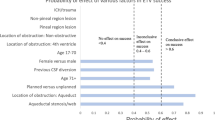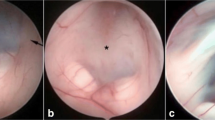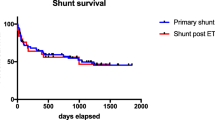Abstract
Background
Endoscopic third ventriculostomy success score (ETVss) is widely utilised to predict outcomes for ETV. Accurate prediction of success for a procedure is of vital importance both for selecting the optimal management plan and for obtaining informed consent. Existing literature demonstrates a variety of opinions on the accuracy of the currently utilised ETVss and recommends a range of techniques to reduce the number of subsequent ventriculo-peritoneal (VP)-shunt insertions, prompting the present study.
Methods
We retrospectively analysed data for ETV cases since 2007 to review success rate in our regional paediatric neurosurgical centre and if the currently utilised ETVss successfully predicted outcomes. Failed ETV cases were defined as any patient who received a VP-shunt at any time following ETV. Data was analysed with MS ExcelR and RStudioR.
Results
44 ETVs were performed over 13 years with approximately equal distribution between male and female patients; median age 7 years (IQR 4–13 years). Overall, mean ETVss for these 44 procedures was 78%; actual success rate was 70% with no statistically significant difference between them (p = 0.286; Welch two sample t-test). Accuracy of ETVss varied with pathology: tectal gliomas (mean ETVss 75% and actual success 78%); cerebellar tumours (mean ETVss 85% and actual success 81%); other tumours (mean ETVss 75% and actual success 81%); aqueduct stenosis (mean ETVss 71% and actual success 69%); and other pathologies (mean ETVss 70% and actual success 60%). < 1 month and 1–6 months and 1–10 years and > 10 years contributed equally to the accuracy of ETVss.
Conclusion
Non-telencephalon tumours and obstruction at the level of the mid-brain are most strongly associated with successful ETV outcome. These findings can be used to modify the currently utilised ETVss to further improve accuracy of outcome prediction. We recommend a modified-ETVss (m-ETVss) and a future larger adequately powered prospective study to validate this.


Similar content being viewed by others
References
Azab, Waleed A., Khurram N, Waleed S 2014 "An overview of the current surgical options for pineal region tumors." Surgical neurology international 5 (2014)
Beltagy El, Ahmed M et al (2010) Endoscopic third ventriculostomy before tumor surgery in children with posterior fossa tumors CCHE experience. Child’s Nervous System 26(12):1699–1704
Drake J, Chumas P, Kestle J, Pierre-Kahn A, Vinchon M, Brown J, Pollack IF, Arai H (2006) Late rapid deterioration after endoscopic third ventriculostomy: additional cases and review of the literature. J Neurosurg 105(2 Suppl):118–126. https://doi.org/10.3171/ped.2006.105.2.118
Dunford AJ, Kirkham FJ, Mathad N et al (2011) Endoscopic third ventriculostomy in the treatment of childhood hydrocephalus: validation of a success score that predicts long term outcome. J Neurosurg Pediatr 8:489–493
Foley RW, Ndoro S, Crimmins D, Caird J (2017) Is the endoscopic third ventriculostomy success score an appropriate tool to inform clinical decision-making? Br J Neurosurg 31(3):314–319. https://doi.org/10.1080/02688697.2016.1229744
Garcia LG, Lopez BR, Botella GI et al (2012) Endoscopic third ventriculostomy success score (ETVSS) predicting success in a series of 50 pediatric patients Are the outcomes of our patients predictable? Childs Nerv Syst 28(8):1157–62. https://doi.org/10.1007/s00381-012-1836-3
Kulkarni AV, Drake JM, Mallucci CI et al (2009) Endoscopic third ventriculostomy in the treatment of childhood hydrochephalus. J Paediatrics 155:254–9 e1
Kulkarni AV, Drake JM, Kestle JR et al (2010) Predicting who will benefit from endoscopic third ventriculostomy compared with shunt insertion in childhood hydrocephalus using the ETV success score. J Neurosurg Paediatric :310–315. https://doi.org/10.3171/2010.8.PEDS103
McLaughlin MR, Wahling JB, Kaufmann AM et al (1997) Traumatic basilar aneurysm after endoscopic third ventriculostomy. Case Rep Neurosurg 41:1400–1404
Naftel RP, Reed GT, Kulkarni AV et al (2011) Evaluating the Children’s Hospital of Alabama endoscopic third ventriculostomy experience using the endoscopic third ventriculostomy success score: an external validation study. J Neurosurgery Pediatr 8:494–501
Persson EK, Anderson S, Wiklund LM, Uvebrant P (2007) Hydrocephalus in children born in 1999–2002: epidemiology, outcome, and ophthalmological findings. Childs Nerv Syst 23:1111–1118
Ruggiero C, Cinalli G, Spennato P, Aliberti F, Cianciulli E, Trischitta V, Maggi G (2004) Endoscopic third ventriculostomy in the treatment of hydrocephalus in posterior fossa tumors in children. Childs Nerv Syst. Child’s Nervous System 20(11–12):828–833. https://doi.org/10.1007/s00381-004-0938-y
Srinivasan HL, Foster MT, van Baarsen K, Hennigan D, Pettorini B, Mallucci C (2020) Does pre-resection endoscopic third ventriculostomy prevent the need for post-resection CSF diversion after pediatric posterior fossa tumor excision? A historical cohort study and review of the literature. J Neurosurg: Pediatrics PED 25(6):615–624
Tamburrini G, Frassanito P, Bianchi F, Massimi L, Di Rocco C, Caldarelli M (2015) Closure of endoscopic third ventriculostomy after surgery for posterior cranial fossa tumor: the “snow globe effect.” Br J Neurosurg 29(3):386–389. https://doi.org/10.3109/02688697.2014.987214
Acknowledgements
The authors would like to acknowledge H Smart and H Zimmer-Smith (Paediatric Neurosurgery Clinical Nurse Specialists).
Author information
Authors and Affiliations
Corresponding author
Ethics declarations
Conflict of interest
The authors declare no competing interests.
Additional information
Publisher's note
Springer Nature remains neutral with regard to jurisdictional claims in published maps and institutional affiliations.
This article is part of the Topical Collection on Pediatric Neurosurgery.
Rights and permissions
About this article
Cite this article
Yordanov, S., Garnett, M.R., Santarius, T. et al. An audit of endoscopic third ventriculostomy (ETV) in a regional paediatric neurosurgical centre assessing the accuracy and feasibility of the ETV success score. Acta Neurochir 164, 1453–1458 (2022). https://doi.org/10.1007/s00701-022-05151-8
Received:
Accepted:
Published:
Issue Date:
DOI: https://doi.org/10.1007/s00701-022-05151-8




